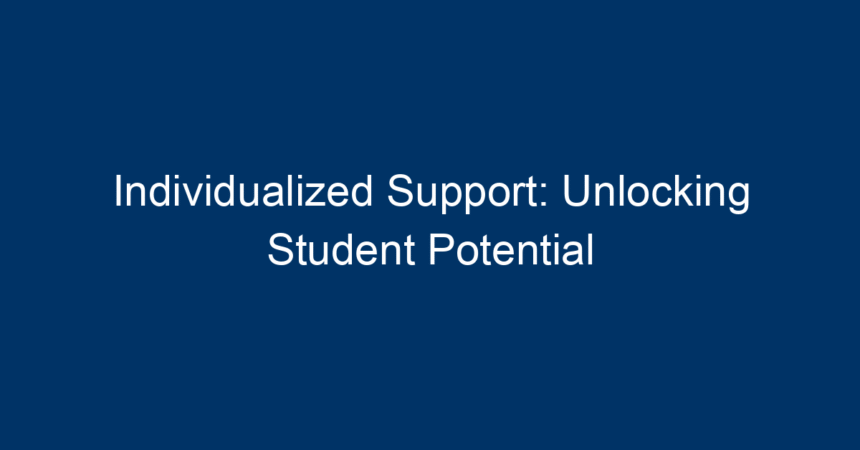Education is often seen as a one-size-fits-all system, but the reality is far more complex. Every student has unique strengths, challenges, and learning styles. Individualized support is the key to unlocking each student’s potential, ensuring they thrive academically and personally. In this article, we will explore the concept of individualized support, its significance in education, the strategies that can be employed, and how schools can effectively implement these methods.
Understanding Individualized Support
What is Individualized Support?
Individualized support refers to educational strategies tailored to meet the specific needs of each student. This approach allows educators to recognize and respond to the diverse capabilities, interests, and backgrounds of learners. By providing personalized attention and resources, educators can significantly enhance student engagement and achievement.
The Importance of Individualized Support
Individualized support is essential for several reasons:
-
Diverse Learning Styles: Students absorb information in different ways. Some are visual learners, while others grasp concepts better through auditory or kinesthetic means. Individualized support helps to cater to these varying needs.
-
Addressing Gaps in Knowledge: Every student comes with a different set of skills and knowledge. Individualized support enables educators to identify gaps and provide targeted assistance.
-
Boosting Confidence: When students receive personalized attention, they often feel more valued and understood. This can significantly increase their motivation and self-esteem.
- Enhancing Engagement: Tailored learning experiences can spark interest and engagement, making students more likely to participate in their education actively.
Key Strategies for Implementing Individualized Support
1. Assessing Student Needs
The first step in providing individualized support is to conduct assessments that identify each student’s strengths, weaknesses, and learning preferences. These assessments can be formal, like standardized tests, or informal, such as class observations and discussions.
- Personalized Learning Profiles: Create profiles for each student that include their assessment results, interests, and goals. This ensures that any support provided is relevant and targeted.
2. Differentiated Instruction
Differentiated instruction involves varying teaching techniques so that all students can access the material despite varying levels of readiness or learning styles.
-
Flexible Grouping: Group students according to their skill level or interests for specific tasks or projects, allowing for more focused instruction.
- Tiered Assignments: Create assignments with varying levels of complexity based on students’ readiness. This encourages all students to engage meaningfully with the material.
3. Personalized Learning Plans (PLPs)
A personalized learning plan outlines specific goals, learning strategies, and resources tailored to a student’s needs.
-
Setting Goals Together: Involve students in setting academic and personal goals to foster ownership of their learning.
- Regular Check-Ins: Schedule consistent meetings to assess progress, adjust goals, and modify the support strategies as necessary.
4. Use of Technology
Technology can be a powerful ally in providing individualized support.
-
Adaptive Learning Software: These programs adjust to a student’s learning pace and style, offering tailored content and assessments.
- Online Resources: Provide students with access to online learning platforms that allow them to explore subjects at their own speed and interest level.
5. Creating a Supportive Classroom Environment
The physical and emotional environment of the classroom plays a critical role in the effectiveness of individualized support.
-
Building Relationships: Foster strong relationships between teachers and students, emphasizing trust and open communication.
- Creating a Safe Space: Ensure that students feel safe to express their ideas and make mistakes. This contributes to a more conducive learning atmosphere.
Lessons from Successful Practices in Individualized Support
Success Stories
Various educational institutions have successfully implemented individualized support with notable outcomes:
-
Montessori Schools: These schools are known for their individualized approach to education, allowing children to learn at their own pace. Students engage with materials that interest them and develop self-directed learning skills.
- Project-Based Learning: Some schools use project-based learning to enable students to work on topics they are passionate about while gaining academic skills. This method encourages collaboration and personal investment in learning.
Evidence-Based Results
Research shows that schools incorporating individualized support strategies see improvements in student performance, engagement, and satisfaction. According to studies, students receiving tailored instruction exhibited higher levels of academic achievement and lower dropout rates.
Challenges of Implementing Individualized Support
While the benefits of individualized support are clear, challenges do exist.
1. Resource Limitations
Many schools may lack the necessary resources, such as staff training, technology, or funding, to effectively implement individualized support systems.
2. Time Constraints
Teachers often juggle numerous responsibilities, making it challenging to provide personalized attention to every student.
3. Resistance to Change
Implementing individualized support requires a shift in mindset for educators and administrators accustomed to traditional teaching methods.
Overcoming the Challenges
1. Professional Development
Provide teachers with training and resources on how to effectively implement individualized support strategies. Workshops and collaborative planning sessions can help educators feel more equipped.
2. Utilize Technology Efficiently
Invest in adaptive learning technologies that can help streamline personalized support while minimizing the time commitment required from teachers.
3. Foster a Culture of Collaboration
Encourage collaboration among educators, students, and parents. Teaming up can help alleviate workloads and create a more robust support system for students.
Conclusion: Actionable Insights for Educators
Individualized support is a vital tool in unlocking the potential of each student. By recognizing each learner’s unique needs and adapting instructional strategies accordingly, educators can promote a more inclusive and effective educational experience. Here are some actionable steps:
-
Conduct thorough assessments at the beginning of the school year to identify student needs.
-
Develop personalized learning profiles for each student, outlining their goals, strengths, and areas for improvement.
-
Explore and implement adaptive learning technologies that facilitate individualized instruction.
-
Foster a supportive classroom environment that encourages open communication and respects diverse learning styles.
- Engage with parents to reinforce individualized support at home.
By taking these actionable steps, educators can transform their classrooms into dynamic learning environments where every student has the opportunity to succeed. Individualized support is not merely a trend; it’s an essential strategy for fostering lifelong learners and empowered individuals. Together, let’s unlock the potential within every student.




